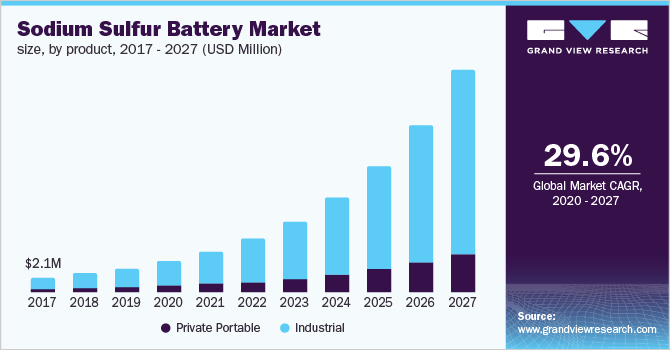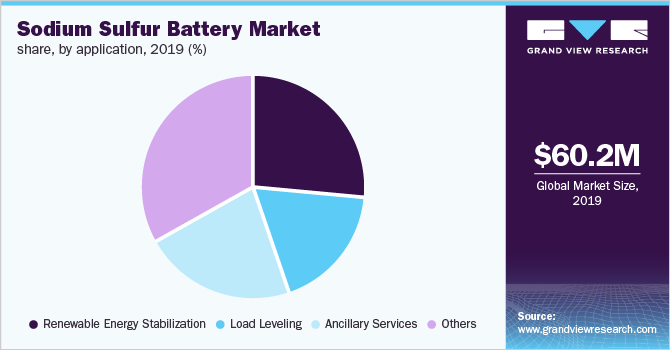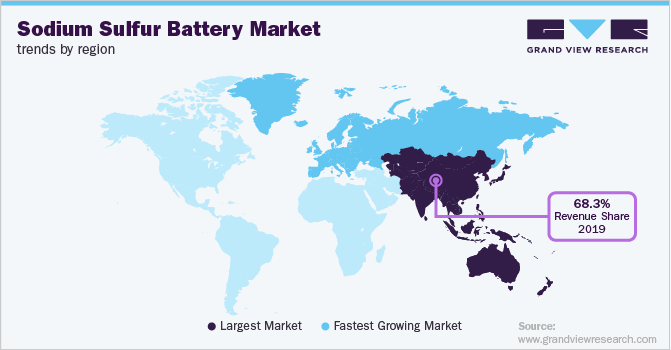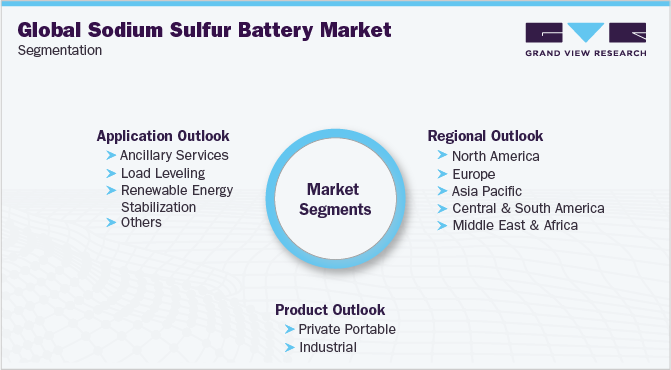- Home
- »
- Power Generation & Storage
- »
-
Sodium Sulfur Battery Market Size & Share Report, 2020-2027GVR Report cover
![Sodium Sulfur Battery Market Size, Share & Trends Report]()
Sodium Sulfur Battery Market Size, Share & Trends Analysis Report By Application (Renewable Energy Stabilization, Load Leveling), By Product (Private Portable, Industrial), By Region, And Segment Forecasts, 2020 - 2027
- Report ID: GVR-4-68039-060-4
- Number of Report Pages: 100
- Format: PDF, Horizon Databook
- Historical Range: 2016 - 2018
- Forecast Period: 2020 - 2027
- Industry: Energy & Power
Report Overview
The global sodium sulfur battery market size to be valued at USD 480.4 million by 2027 and is expected to grow at a compound annual growth rate (CAGR) of 29.6% during the forecast period. Growing demand for energy storage and power using sodium sulfur (NaS) batteries across the globe is projected to boost the growth of the market during the projected timeframe. Besides, as sodium sulfur batteries are smaller in size, they are more appropriate for areas where other energy storage choices are not viable. Sodium sulfur batteries allow deferral of transmission up-gradation as the power does not have to be transmitted directly after generation, hence it can also be discharged on demand. Moreover, sodium sulfur batteries are used for the steadying of emergency power supply and power supply for micro/off-grid and industrial customers. However, the adoption rate is a little low owing to the presence of alternative battery technologies, including Li-ion and lead-acid batteries.

The U.S. market size was valued at USD 3.82 million in 2019. The U.S. government has been cheering stakeholders for the renewable industry, resulting in improved demand for Battery Energy Storage Systems (BESS), mainly led by sodium sulfur batteries. Encouraging industrial sector growth, along with energies to sustain grid stability with the integration of renewable sources of energy, will further propel industry statistics across the country.
The threat of moisture is more important for NaS batteries, which is giving rise to regular servicing of the batteries as well as individual cell inspection to guarantee better operation for a longer period of time. Periodic inspection and maintenance, sealing costs, installation in inaccessible locations, and regulations on distributed energy storage (DES) are some of the factors limiting the growth of the global market.
However, the global economy has been severely struck by an unexpected outburst of the novel coronavirus, with a deep impact on the global market. The outbreak has delayed a wide range of projects, such as energy storage batteries and renewable integration, owing to a large-scale disturbance in supply chains and a lack of manpower, which is impacting the overall market growth.
Sodium Sulfur Battery Market Trends
Globally, the market is being driven by increasing product application in renewable energy projects, as well as significant advancements in cell configuration, separator, and electrolyte. The NaS cells are high-temperature batteries designed for grid-scale applications. As a result, many companies are starting to use sodium-sulfur batteries in sustainable energy storage systems.
The power generation industry has seen a surge in the prevalence of renewable projects that have been supplemented with energy storage devices. Several projects utilizing sodium-sulfur battery systems are still being introduced into the national grid of several nations. For instance, in 2021, NGK Insulators signed a contract with JGC Holdings to supply sodium-sulfur batteries for the latter’s solar plus storage project.
The increasing electricity demand from different sectors owing to its importance for carrying out day-to-day activities is expected to propel the demand for energy storage systems (ESS); as a result, this makes way for numerous opportunities for the market. However, the market expansion is hampered by some constraints, such as the highly corrosive character of sodium polysulfides, which makes them unsuitable for compact mobile applications.
Product Insights
On the basis of the product, the market is segregated into private portable and industrial batteries. The industrial product segment accounted for 81.8% share of the total revenue in 2019 owing to the growing demand for sodium sulfur batteries in industrial and grid storage locations as they offer high-energy density solutions. Hence, the demand for sodium sulfur batteries across the industrial sectors is likely to upsurge with the intensifying need for storage and power backup.
The private portable product segment is expected to expand at a CAGR of 28.3% from 2020 to 2027. The adoption of NaS batteries in portable devices is expected to grow at a significant rate owing to low maintenance properties and higher energy densities of the batteries. High demand for consumer electronics is expected to propel the segment growth.
Application Insights
On the basis of application, the market is segregated as ancillary services, load leveling, renewable energy stabilization, and others. The Others application segment held the largest share of 33.0% in 2019. The ancillary services application segment is expected to register a CAGR of 30.6% from 2020 to 2027. Ancillary service is required to maintain reliable, secure, and safe transmission of energy on the grid areas. The load leveling application segment is expected to emerge as the fastest-growing segment over the forecast period.

The renewable energy stabilization segment is projected to witness substantial growth in the years to come. Sodium sulfur batteries are used as energy storage batteries to support renewable energy generation, mainly in solar generation and wind farms. The battery energy storage system has a significant influence on creating rapid decarbonization for energy usage purposes. The battery energy storage systems provide stability services to various mini-grids, facilitate a surge in the potential share of variable renewable sources of energy in such grid areas, and improve the power quality.
Regional Insights
The Asia Pacific accounted for the largest revenue share of 68.27% in 2019 and is expected to witness significant growth during the projected period. Rising investments in expanding electricity generation capacities, along with growing demand for electrification in rural areas, will foster the demand for storage batteries across the Asia Pacific region, leading to increasing demand for sodium sulfur batteries.

Japan leads the global adoption of sodium sulfur batteries with over 170 MW of installed capacity by 2018. Sustained industrialization across major economies in the region has led to an increasing emphasis on grid stability and dependable electricity generation. As a result, sodium sulfur batteries are gradually being deployed to provide ancillary services with proper frequency regulation. Rising efforts to lessen the carbon footprint by enhancing renewable source energy infrastructure will further boost the market growth.
Europe is likely to witness noteworthy growth in the years to come on account of increasing demand for NaS batteries. Technological advancements in terms of cost-effectiveness, enhanced efficiency, and product innovation are projected to boost the regional market growth. Stringent emission norms by the governments of developed countries, such as the U.K. and the U.S., coupled with rising attention toward fuel efficiency, are projected to drive the market.
Key Companies & Market Share Insights
The market for sodium sulfur batteries has been characterized by high competition owing to the presence of major companies. Business expansion has emerged as the main focus area for the market participants. Market players are increasingly targeting developing countries to tap the rising demand for NaS batteries. Moreover, market players are investing in product development to consolidate and enhance their market share across the industry. For instance, in 2019, NGK and BASF announced the expansion of their existing partnership to a joint development agreement (JDA) to develop next-generation sodium sulfur batteries.
Recent Developments
-
In May 2022, GE Electric launched Lifespan, a new renewable energy digital suite that enables consumers to optimize the performance and operations of renewable assets across the region. It will also assist operators in engaging with the valuable insights needed to effectively take action across all elements of their enterprise
-
In November 2021, NGK Insulators, Ltd. collaborated with Ricoh Company, Ltd., for a trial project to track the entire process of renewable energy, from generation to consumption. This also includes the charging and discharging of excess produced electricity in sodium-sulfur batteries to store electricity
-
In October 2021, BASF New Business (BNB) commissioned battery storage composed of four NAS battery containers, linked to the power grid at BASF's Verbund facility in Antwerp, Belgium
Some of the prominent players in the sodium-sulfur battery market include:
-
NGK INSULATORS, LTD.
-
BASF SE
-
Tokyo Electric Power Company Holdings, Inc.
-
EaglePicher Technologies
-
GE Energy
-
FIAMM Group
-
KEMET Corporation
-
POSCO
-
Sieyuan Electric Co., Ltd.
Sodium Sulfur Battery Market Report Scope
Report Attribute
Details
Market size value in 2020
USD 78.03 million
Revenue forecast in 2027
USD 480.4 million
Growth Rate
CAGR of 29.6% from 2020 to 2027
Base year for estimation
2019
Historical data
2016 - 2018
Forecast period
2020 - 2027
Quantitative units
Revenue in USD million and CAGR from 2020 to 2027
Report coverage
Revenue forecast, company ranking, competitive landscape, growth factors, and trends
Segments covered
Application, product, region
Regional scope
North America; Europe; Asia Pacific; Central & South America; Middle East & Africa
Country scope
U.S.; Canada; U.K.; South Korea; China; Japan; Brazil; South Africa
Key companies profiled
NGK INSULATORS, LTD.; BASF SE; Tokyo Electric Power Company Holdings, Inc.; EaglePicher Technologies; General Electric; FIAMM Group; KEMET Corporation; POSCO; Sieyuan Electric Co., Ltd.
Customization scope
Free report customization (equivalent up to 8 analysts working days) with purchase. Addition or alteration to country, regional & segment scope.
Pricing and purchase options
Avail customized purchase options to meet your exact research needs. Explore purchase options
Global Sodium Sulfur Battery Market SegmentationThis report forecasts revenue growth at the global, regional, and country levels and provides an analysis of the latest industry trends and opportunities in each of the sub-segments from 2016 to 2027. For the purpose of this study, Grand View Research has segmented the global sodium sulfur battery market report on the basis of application, product, and region.

-
Application Outlook (Revenue, USD Million, 2016 - 2027)
-
Ancillary Services
-
Load Leveling
-
Renewable Energy Stabilization
-
Others
-
-
Product Outlook (Revenue, USD Million, 2016 - 2027)
-
Private Portable
-
Industrial
-
-
Regional Outlook (Revenue, USD Million, 2016 - 2027)
-
North America
-
The U.S.
-
Canada
-
-
Europe
-
The U.K.
-
-
Asia Pacific
-
China
-
Japan
-
South Korea
-
-
Central & South America
-
Brazil
-
-
Middle East & Africa
-
South Africa
-
-
Frequently Asked Questions About This Report
b. The global sodium sulfur battery market size was estimated at USD 60.19 million in 2019 and is expected to reach USD 78.03 million in 2020.
b. The global sodium sulfur battery market is expected to grow at a compounded annual growth rate of 29.6% from 2020 to 2027 to reach USD 480.38 million by 2027.
b. Asia Pacific dominated the sodium sulfur battery market with the highest share of 68.27% in 2019. Japan dominates the global market with over 300 MW of NaS storage power installed in over 170 locations across the country.
b. Some key players operating in the sodium sulfur battery market include NGK INSULATORS, LTD., BASF SE, Tokyo Electric Power Company Holdings, Inc., EaglePicher Technologies, GE Energy, FIAMM Group, KEMET Corporation, POSCO, Sieyuan Electric Co., Ltd. among others.
b. Sodium sulfur batteries allows deferral of transmission upgradation, since the power does not have to be transmitted directly after generation hence it also can be discharged on demand. Moreover, sodium sulfur batteries are used for the steadying of emergency power supply and power supply for micro/off grids and industrial customers, leading to a substantial growth in the adoption.
Share this report with your colleague or friend.
![gvr icn]()
NEED A CUSTOM REPORT?
We can customize every report - free of charge - including purchasing stand-alone sections or country-level reports, as well as offer affordable discounts for start-ups & universities. Contact us now
![Certified Icon]()
We are GDPR and CCPA compliant! Your transaction & personal information is safe and secure. For more details, please read our privacy policy.
We are committed towards customer satisfaction, and quality service.
"The quality of research they have done for us has been excellent."





